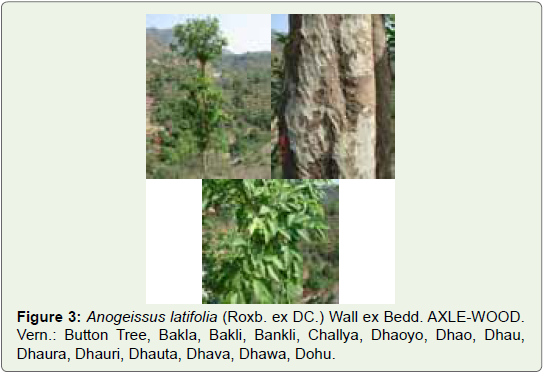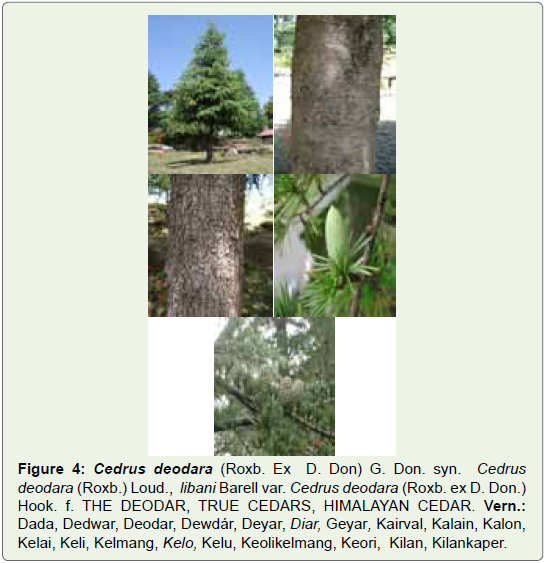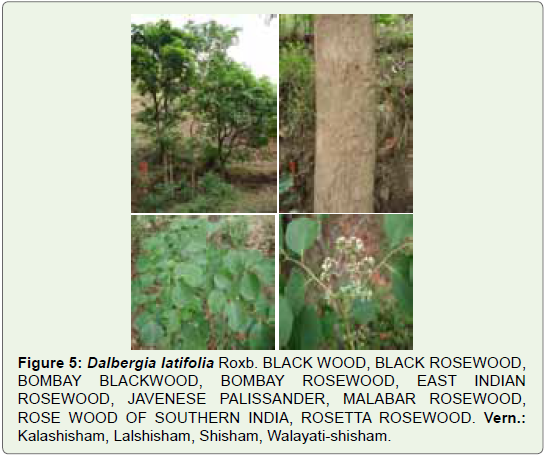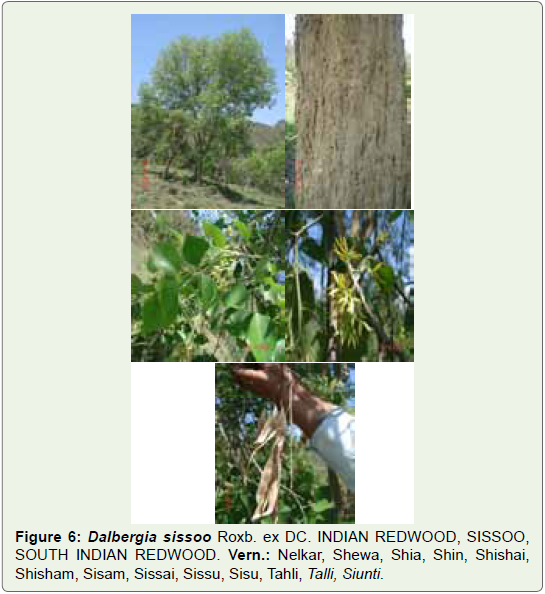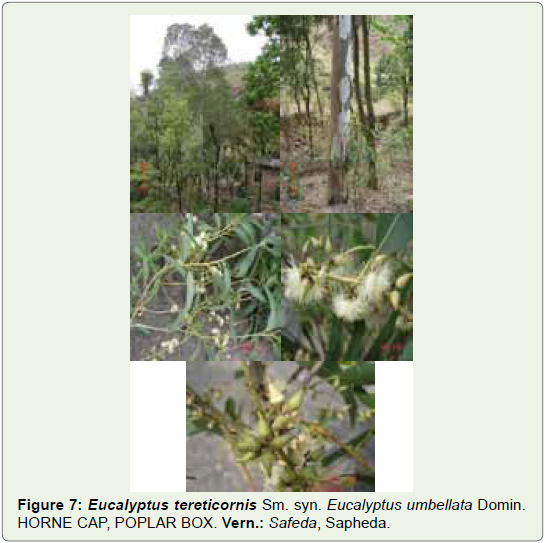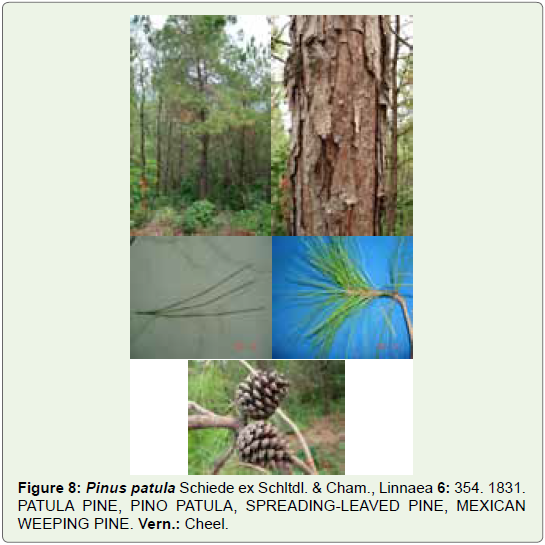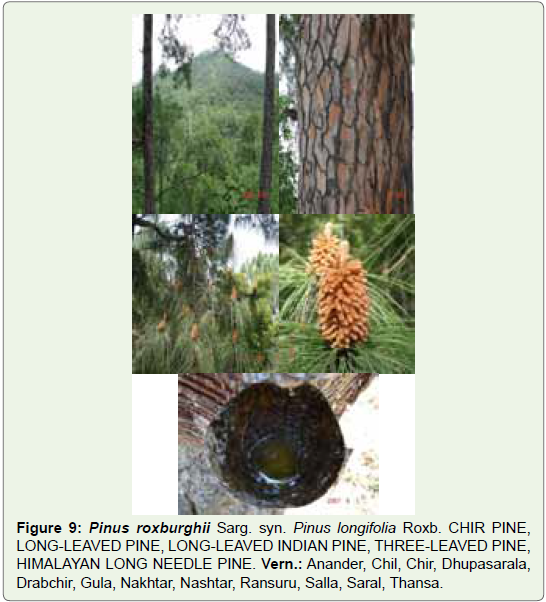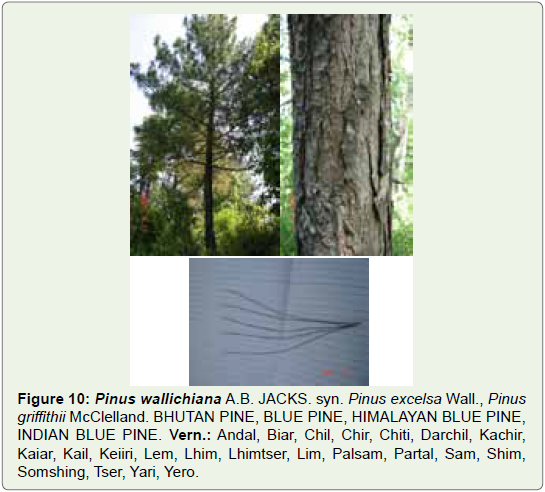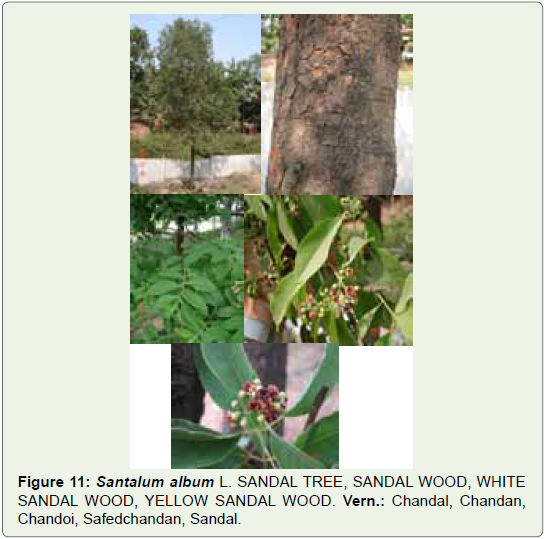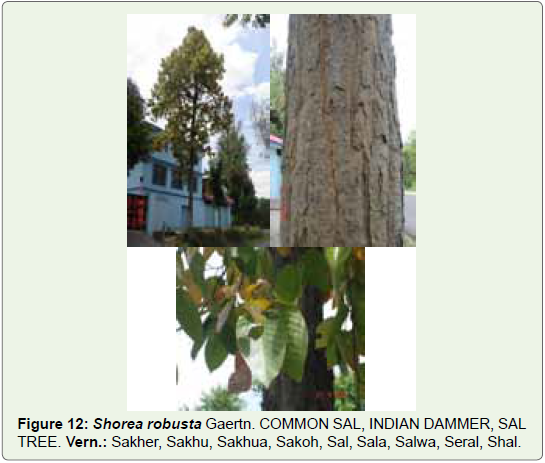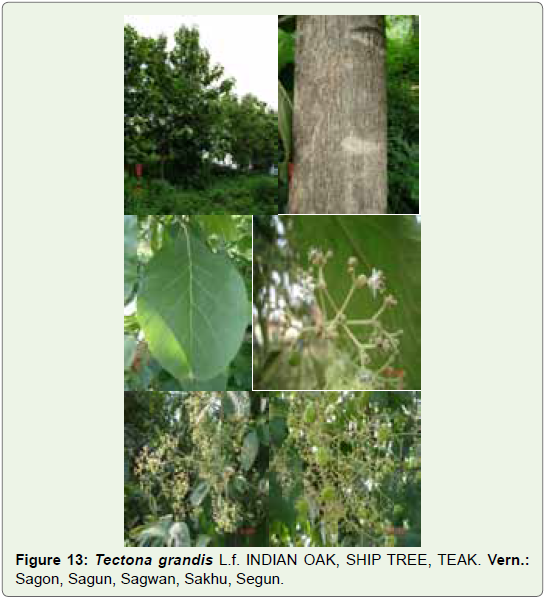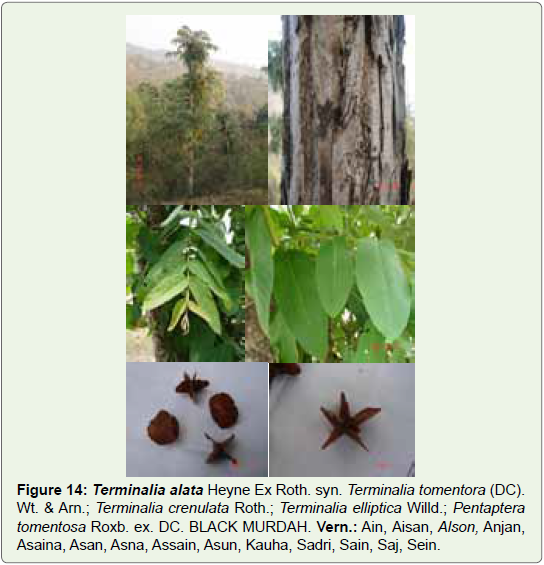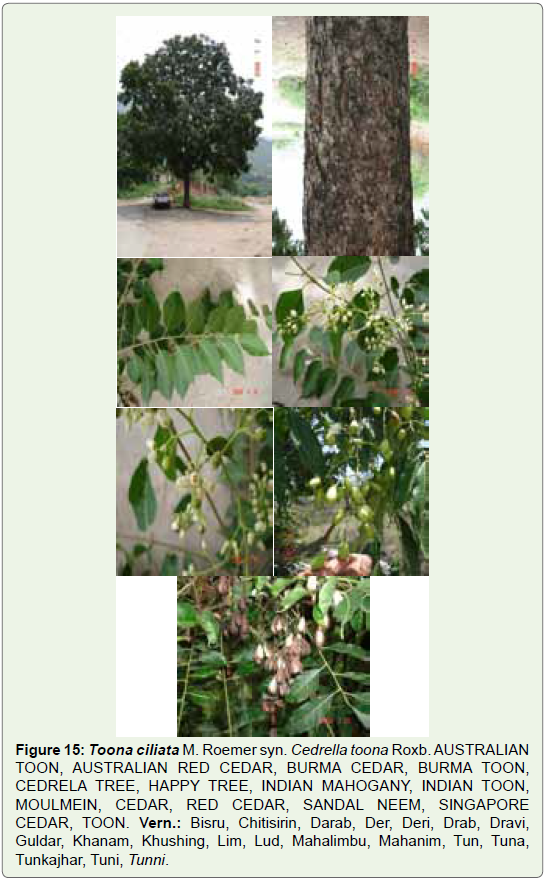Research Article
Common Timber Yielding Plants of District Bilaspur of Himachal Pradesh, India
Mahender K*
Department of Botany, Govt P.G. College Ghumarwin, India
*Corresponding author: Mahender K, Associate Professor, Department of Botany, Govt P.G. College Ghumarwin,
District Bilaspur, PIN 174021 (H.P.), India; Email: mahender2629@gmail.com
Copyright: © Mahender K. 2021. This is an open access article distributed under the Creative Commons Attribution License, which
permits unrestricted use, distribution, and reproduction in any medium, provided the original work is properly cited.
Article Information: Submission: 26/05/2021; Accepted: 28/06/2021; Published: 01/07/2021
Abstract
This paper deals with the 13 timber yielding plant species viz. Anogeissus latifolia, Cedrus deodara, Dalbergia latifolia, Dalbergia sissoo, Eucalyptus
teriticornis, Pinus patula, Pinus roxburghii, Pinus wallichiana, Santalum album, Shorea robusta, Tectona grandis, Terminalia alata and Toona ciliata of district
Bilaspur of Himachal Pradesh. Out of them 04 species are SOFT WOOD (Gymnosperms) while 09 species are HARD WOOD (Angiosperms). Personal
survey of the district was carried out in order to ascertain the common timber yielding plants. Plants were collected from different parts of the district and were
identified using standard procedures. Important vegetative and floral characterstics of plants were noted as well as their photographs were also taken in the
field. Herbarium mounts of plants were prepared for records and identification. For the identification and description of plants the terminologies followed are in
accordance with the International Plant Names Index and The Plant List (2013). The Natural System of Classification of Spermatophytes, given by Bentham
and Hooker (1862- 1883) and Hooker (1872-1897) along with latest amendments have been followed in this paper.
Keywords
Timber Plants; Secondary Xylem; Wood; Gymnosperms; Angiosperms; Bilaspur (HP)
Introduction
Since the time immemorial wood has been used by the man for
house building and subsequently for furniture making. Therefore,
plants are invaluable to mankind in the form of wood, which is the
secondary xylem of woody plants. Based upon the type of plants,
wood is of two types: SOFT WOOD and HARD WOOD. Soft Wood is
obtained from Gymnosperms while Hard Wood from Angiosperms.
Both types of Wood have their own significance. Wood is not only
used for domestic purposes but for commercial purposes also.
Bilaspur is the second smallest and one of the twelve districts of
Himachal Pradesh. Bilaspur is surrounded by Hamirpur and Mandi
districts on the North, Mandi, and Solan on the East, Solan district
and Punjab State on South while Una and Hamirpur districts on
the West side. This is situated between 310 12/ 30// and 310 35/ 45//
North latitude and 760 23/ 45// and 760 55/ 40// East longitude in the
outer hills of the Himalayas. The river Satluj flows through the district
Bilaspur for about 90 KM. This river enters the district Bilaspur at KARAHI KA GHARAAT near the village Kasol, near Kol dam and
leaving it at the village NEILA near the Bhakhra dam. Its area is
1167 Sq Km. The altitude of Bilaspur varies from 290 metres to 1980
metres, consequently great variations in its flora.
The objective of this paper is to identify the common timber
yielding plants of the district Bilaspur of Himachal Pradesh along
with their sytematics, common names, vernacular names, citations,
morphological features, flowering and fruiting seasons, places of
collection, habitat, as well as their distribution in the World, India,
and Himachal Pradesh along with the economic and ethnobotanical
uses. Coloured photographs of plants are also taken in the field.This
paper aims to make readers and researchers more aware about the
importance as well as motivate them for the conservation of plants
for the future generations.
Materials and Methods
Extensive field survey of different places at different times of the district Bilaspur has been carried out during 2009 to 2014. Standard
Procedures are followed for the collection, preservation, and
identification of plants. Important vegetative and floral characteristics
of plants have been noted as well as their photographs are also taken
in the field. Herbarium mounts of these plants are prepared for record
and identification. While describing and identifying the plants, we
strictly adhered to the terminologies used by Haris and Haris (1994),
Jain and Rao (1977), Polunin and Stainton (1984), Stainton (1988)
and Womersley (1981). The nomenclature of plants is in accordance
with the International Code of Nomenclature (ICN), International
Plant Names Index (IPNI), The Plant List (2013) and Bannet (1987).
The Natural System of Classification of Spermatophytes, given by
Bentham and Hooker (1862-1883) and Hooker (1872-1897) along
with latest amendments have been followed in this paper.
Observations
In order to enumerate the timber yielding plants, extesive survey
of the district Bilaspur has been carried out during different seasons. A
total of 13 species belonging to 10 genera and 08 families are reported.
04 plant species are gymnosperms belonging to single family while 09
plant species are angiosperms belonging to 07 different families. The
family Pinaceae (gymnosperm) comprises 02 genera and 04 species.
The angiospermic families like Combretaceae and Papilionaceae
includes 02 species each but rest of the five families- Dipterocarpaceae,
Meliaceae, Myrtaceae, Santalaceae and Verbenaceae has one species
each.
Dalbergia latifolia has been introduced by Sh. H.M. Bhatia,
Retired IFS officer (PCCF) of Rajasthan cadre to the village Chamog.
Pinus patula has been reported from the nursery garden of ACC
Limited at Barmana. Dalbergia sissoo, Toona ciliata and Eucalyptus
teriticornis are reported to be growing very well throughout the
district. Anogeissus latifolia is abundant in Swarghat Forest Range
and Kotdhar region of Kalol Forest Range while it is less abundant
in Sadar Forest Range. Santalun albumis growing very well in the
Changer sector and in the campus of Govt. P.G. College Bilaspur.
Terminalia alata is abundant in Jhandutta Forest Range. Tectona
grandis has been found to be growing in dense patches at Jhandutta,
Ghumarwin, Chabyon (near Kol Dam) while it is sporadic in other
parts of Bilaspur. Cedrus deodara and Pinus wallichiana are restricted
to Bahadurpur region while Pinus roxgurghii is very common species
of this district.
Results and Discussions
Thirteen different species of timber yielding plants viz.
Anogeissus latifolia, Cedrus deodara, Dalbergia latifolia, Dalbergia
sissoo, Eucalyptus teriticornis, Pinus patula, Pinus roxburghii, Pinus
wallichiana, Santalum album, Shorea robusta, Tectona grandis,
Terminalia alata and Toona ciliata are collected and identified from
the district Bilaspur of Himachal Pradesh. These timber yielding plant
species are described alphabetically as under:
1) Anogeissus latifolia (Roxb. ex DC.) Wall ex Bedd. Fl. Sylv.
S. India 1: 15 1869; FBI. 2: 450. 1878; Kanjilal, For. Fl. Chakrata,
Dehradun & Saharanpur. 254. 1901; Brandis, Ind. Trees. 315. 1906;
PP. 36. 1916; FF. 240. 1918; FHP. 1: 282. 1984; FSIR. 299. 2004.
Conocarpus latifolia Roxb. ex DC. Prodr. 3: 17. 1828; Roxb. Fl. Ind.
(ed. Carey) 2: 442. 1832. Family Combretaceae. AXLE-WOOD.
Vern.: Button Tree, Bakla, Bakli, Bankli, Challya, Dhaoyo, Dhao,
Dhau, Dhaura, Dhauri, Dhauta, Dhava, Dhawa, Dohu. Figure 3.
Figure 3: Anogeissus latifolia (Roxb. ex DC.) Wall ex Bedd. AXLE-WOOD.
Vern.: Button Tree, Bakla, Bakli, Bankli, Challya, Dhaoyo, Dhao, Dhau,
Dhaura, Dhauri, Dhauta, Dhava, Dhawa, Dohu.
It is a large deciduous tree. Bark smooth, greenish-white. Leaves
are alternate or inconstantly opposite, 5-10 cm long, elliptic, entire,
sub-coriaceous, acute or obtuse, glabrous; secondary nerves 8-14
pairs, tertiary nerves prominent beneath; petioles 0.5-1 cm long.
Flower- heads are 5-10 mm across, axillary; peduncles 0.5-1 cm long.
Calyx is campanulate, tube 0.4-0.5 mm long, laterally 2-winged, long and narrowed above the ovary, teeth minute, triangular, persistent.
Petals are absent. Stamens 10, in 2 series, exserted.
Ovary is 1-celled. Ovules are 2, pendulous. Fruits a dry drupe, 4-5
mm long, beak 2.5-3 mm long, 2-winged, yellowish-green; in dense ±
1cm across heads. Flowering and Fruiting: May- June.
Specimens examined: Swarghat, 25 July, 2011, Mahender. 190,191.
Habitat: Common. Distribution: Himalayas to Sri Lanka; India
Himachal Pradesh: Bilaspur, Sirmaur (Saketi, Kala Amb, Nahan,
Renuka), Kangra (DD, RRL). Altitude: 400-1100 meters.
Economic and Ethnobotanical Uses: Wood is used for axles,
shafts, poles, batons, agricultural implements, and tool handles; also
suitable for furniture, construction purposes [1]. Tree yields a gum
which is used in pharmaceutical preparations, for sizing paper and
calico printing. Tasar silkworm is fed on its leaves. Root is useful in
vitiated conditions of ‘kapha’, ‘vata’ and abdominal disorders. Bark
improves both taste and appetite; removes ‘kapha’ and ‘vata’, useful
in anaemias, urinary discharges, wounds, ulcers, inflammations,
diabetes, haemorrhages, dysentery, piles; applied in skin diseases and
erysepelas. Leaves juice is given in purulent discharges from the ear.
Fruit is cooling, astringent to bowels; increases ‘vata’; cures ‘kapha’
and biliousness [2,3].
2) Cedrus deodara (Roxb. ex D. Don) G. Don in Loud. Hort.
Brit. Ed. 388. 1830; Troup, Silvi. Ind. Trees III: 1096. f.445-448. 1921;
Raizada & Sahni, Living Ind. Gymno. Ind. For. Rec. (n.s.) Botany 5
(2): 129. f.9. t.VIII. f.4. 1960; FBH. 2. 1977; Polunin & Stainton, Fls.
Himal. 386. f.510.1984; Naithani, Fl. Chamoli 2: 762. 1985; Stainton,
Fls. Himal. Supplement 59. t.112. f.499.1988; Sahni, Gymno. India &
Adj. Countr. 86. t.13. f.1. 1990; FLS. 580. 1994; FK. 707. 1999;Gaur,
Fl. Garhwal. 51. 1999; FGHNP. 269. 2000; FSIR. 698. 2004; FC. 830.
2006. Pinus deodara Roxb. (Hort. Beng. 69. 1814, nom.nud.) ex D.
Don in Lamb. Descr. Genus Pinus 2: 8. 1824; Roxb, Fl. Indica. ed.
2.3. 651. 1832. Cedrus libani Barell var. deodara (Roxb. ex D. Don)
Hook.f. in Himal. J. 1: 257. 1854; FBI. 5: 653. 1888; FS. 486. f.159.
1902, 1921; PP. 40. 1916. Cedrus deodara Loud. Stewart. PP. 220. 1869;
Kanjilal, For. Fl. Chakrata, Dehradun & Sharanpur. 549. 1901; Brandis,
Ind. Trees. 691. 1906; FF. 544. 1918. Family Pinaceae. THE DEODAR,
TRUE CEDARS, HIMALAYAN CEDAR. Vern.: Dada, Dedwar,
Deodar, Dewdár, Deyar, Diar, Geyar, Kairval, Kalain, Kalon, Kelai, Keli,
Kelmang, Kelo, Kelu, Keolikelmang, Keori, Kilan, Kilankaper Figure 4.
Figure 4: Cedrus deodara (Roxb. Ex D. Don) G. Don. syn. Cedrus
deodara (Roxb.) Loud., libani Barell var. Cedrus deodara (Roxb. ex D. Don.)
Hook. f. THE DEODAR, TRUE CEDARS, HIMALAYAN CEDAR. Vern.:
Dada, Dedwar, Deodar, Dewdár, Deyar, Diar, Geyar, Kairval, Kalain, Kalon,
Kelai, Keli, Kelmang, Kelo, Kelu, Keolikelmang, Keori, Kilan, Kilankaper.
A long-living, very large, evergreen tree up to 80-90 m in height
and 12-15 m in girth, young trees cone-like in appearance, but old
ones usually with rounded and flattened tops. Bark green or gray, thin
and smooth on young trees, but 0.5-3 cm thick, dark grayish brown,
dark brown, sometimes reddish or black, divided into irregular
oblong scales or plates with vertical as well as diagonal cracks, quite
rough, deeply furrowed in old stems. Blaze is 3.8-5 cm, pinkish brown.
Branches are irregular, horizontal, slightly ascending, descending
or spreading, never in whorls, leading shoots and tips of branches
usually drooping. Young or New shoots with pale green leaves appear
in March or early April and are covered with grayish down. Shoots
(Branchelets) dimorphic. Long shoots or shoots of unlimited growth
long, slender, bearing scaly leaves, spirally arranged foliar leaves and
dwarf shoots. Dwarf shoots or shoots of limited growth are short, thick, bearing tufts of leaves (15-20) in pseudo whorls. Every year it
elongates slightly and a new whorl of leaves is added, successive years
of growth being marked by a ring of recurved bud scales; sometimes
bears flowers or occasionally develop into long shoots. Winter buds
small, ovoid, with brown scales, which persist on the shots even after
the appearance of young leaves. Leaves dark green, 2.5-5 cm long,
acicular, stiff or rigid, sharply pointed, triquetrous (3-sided), glaucous
or silvery, amphistomatic with two rows of marginal resin canals
on the inner surface, persistent, lasting 1-6 years. Leaf shedding
occurs in May or sometimes in October-November at the time of
cone ripening. Strobili (cones or flowers) solitary, erect, terminal
borne on short shoots, appearing in July-August, maturing during
late September, unisexual and dioecious, sometimes monoecious, in
latter case, they are borne on separate branches. Male cones solitary,
terminal on dwarf shoots, oblong, ovoid or cylindrical, 2.5-4.5 cm
long and 1-1.5 cm in diameter, pale green when young, yellowishgreen
with purplishtinge when mature, each consisting of numerous
microsporophylls (stamens) arranged spirally on a broad central
axis, each stamen with two abaxially placed, oblong microsporangia
or pollen sacs, the connective of which is produced into a flattened
ovate, obtuse, upturned, beak-like appendage with an irregularly
crenulate margin. Depending upon the altitude, locality and season
male cones appear during March-June and shed their pollens from
September to October. Before shedding, they elongate rapidly to
5-7.5 cm in length and turn yellow. Pollen grains are winged, golden.
Pollination occurs in October. Young Female strobili or cones
appear in August, erect, solitary, terminal on dwarf shoots, arising
progressively every year towards the terminal end on the upper side
of horizontal branches, scaly leaves of unequal sizes enclosing the
young cones, each consisting of a broad central axil on which are
present spirally arranged bract scales, in the axis of which are present
fan-shaped ovuliferous scales bearing two inverted ovules on the adaxial surface. Many of the ovuliferous scales present at the base and
apex are sterile. At the time of pollination, the cones are difficult to
find as they are inconspicuous and partly hidden by rosettes of leaves.
They are narrowed to a claw-like process at the base, bract scales
often enlarging after flowering time and larger than the ovuliferous
scales. They are pale glaucous green, oblong or ovoid, 1.2-2 cm long
and 0.6 cm in diam. They are however, in an open state to receive
pollen grains, as the scales stand perpendicular to the axis and the
ovules are exposed. After pollination, the sporophylls grow slightly
and cone becomes compact and finally closes. Growth ceases until the
following spring, i.e. March of next year. By early part of May next,
they become barrel shaped and increase to 8-12 cm in length and
5-8 cm in diam, with fan shaped, 3-3.5 cm broad ovuliferous scales.
By the end of June or during July, they become full sized and are
pale bluish green. During August they turn chocolate-brown, ripen
from September to November and finally turn woody and brown in
colour. Thus, the time taken from the first appearance of the female
strobili to the ripening of cones is about 12½ - 13½ months. Ripe
(Mature) Female cones large, 10-15 cm by 7.5-10 cm, erect, barrelshaped,
ovoid, ellipsoidal or cylindrical, brown, resinous, on short
stout stalks, bracts minute or absent, ovuliferous scales woody, closely
overlapping, fan shaped with a basal stalk-like claw, breaking up on
the tree and shedding the winged seeds along with cone scales, the
central axis persisting for a long time on the tree. Seeds pale brown,
triangular, two to each ovuliferous scale, winged, each with a broad
membranous apical wing, 0.8-1.6 cm long (with wings 2.5-3.8 cm
long), wings with round corners, larger than the seeds, being 1.7-
2.5 cm. Germination epigeous. Cotyledons 9-11. Seed shedding up
to December in certain localities. At the time of shedding, the cone
breaks up on the tree, the scales and seeds falling to the ground and
persistent woody axis remaining for years on the branches.
Specimens examined: Bahadurpur, 17 April 2010, Mahender. 67, 68.
Habitat: Evergreen pyramidal shaped trees, typically gregarious,
often found in pure stands, common in temperate slopes, also found
in association with Picea smithiana and Pinus wallichiana, and
infrequently with oaks, maple, cherries, chestnuts and other broadleaved
species, often planted in hill stations in Europe, America and
other parts of the world. Distribution: Afghanistan, Asia Minor, Atlas
Mountains (Africa, Algeria), Cyprus, Mediterranean mountains,
Nepal (Kurnauli valley), Pakistan (Chitral, Dir, Dungagale, Hazara,
Kagan valley, Thundi, Trans Indus), Syrian mountains, W. Himalayas.
India: Jammu & Kashmir, Uttarakhand (Almora, Chakrata, Jaunsar,
Kumaon, Mussoorie, Nainital, Ranikhet, Tehri-Garhwal). Himachal
Pradesh: Chamba (Dalhousie, Kala Top, Khajjiyar, Pangi, Tisa),
Kangra (Bara-Bangal, Chhota-Bangal, Dhauladhar near McCleodganj
to Dharamkot, Palampur, Tathwani), Kinnaur (Jangi, Kalpa, Nichar,
Rundung, Ralli), Kullu (Bahu, Banjar, Chowai, Jaloripass, Khanag,
Kullu, Manali, Manikaran, Nagar, Pulga, Seraj), Lahaul&Spiti
(Kali, Miyar nala, Lahaul), Mandi (Junee, Karsog, Mandi, Nachan,
Suket), Shimla (Baghi, Bushahr, Boileauganj, Chachpur, Charabra,
Chopal, Chota Shimla, Fagu, Glen, Jakhoo Hills, Jubbal, Khadrala,
Kharapathar, Kotgarh, Kufri, Mahasu, Nankheri, Naldhera, Potter’s
Hill, Rohru, Summer Hill, Tara Devi), Solan (Kasauli, Solan), Sirmaur
(Churdhar, Haipurdhar, Haban, Nauradhar, Rajgarh). Altitude:
1200-3300 m.
Economic and Ethnobotanic Uses: Its wood is the strongest,
most valuable and the best among coniferous woods. It is an
important constructional timber and is extensively employed for
construction, beams, floorboards, posts, cooperage, door and window
frames, furniture, packing cases, spars and shingles and railway
sleepers. It is also used for bridge construction, wagon building, brush
backs, carriages and several other purposes. It is suitable for pattern
making, poles for carrying high tension lines, battery separators, and
second grade pencils] [1,4,5]. Due to the presence of oil, seasoned
heartwood is durable and is rarely attacked by white ants and fungi
[6]. Needles contain ascorbic acid and yield an essential oil [7,8,9].
(Simson and Rau, 1922; Kirtikar and Basu, 1935; Raizada and Sahni,
1960; Ambasta, 1986; Gaur, 1999; Joshi, 2000; Pullaiah, 2002; Seth,
2003, 2006; Sharma, 2003; and Singh and Kumar, 2000).
3) Dalbergia latifolia Roxb. Kanjilal, For. Fl. Chakrata, Dehradun
& Saharanpur. 200. 1901; Brandis, Ind. Trees. 233. 1906; Parker,
FF. 167.1956. Family Papilionaceae. BLACK WOOD, BLACK
ROSEWOOD, BOMBAY BLACKWOOD, BOMBAY ROSEWOOD,
EAST INDIAN ROSEWOOD, JAVENESE PALISSANDER,
MALABAR ROSEWOOD, ROSE WOOD OF SOUTHERN INDIA,
ROSETTA ROSEWOOD. Vern.: Kalashisham, Lalshisham, Shisham,
Walayati-shisham Figure 5.
Figure 5: Dalbergia latifolia Roxb. BLACK WOOD, BLACK ROSEWOOD,
BOMBAY BLACKWOOD, BOMBAY ROSEWOOD, EAST INDIAN
ROSEWOOD, JAVENESE PALISSANDER, MALABAR ROSEWOOD,
ROSE WOOD OF SOUTHERN INDIA, ROSETTA ROSEWOOD. Vern.:
Kalashisham, Lalshisham, Shisham, Walayati-shisham.
It is a large deciduous tree with thick boughs and spreading
crown. Bark grey, smooth or less furrowed. Leaves with longer
rachises; leaflets 3-7, 1-7.5 cm long, broadly elliptic, orbicular or
elliptic-obovate, obtuse, sometimes emarginate. Flowers whitish, 0.5
cm long, on pedicels nearly as long as calyx tube; in short, axillary
and much branched panicles. Stamens are 9. Ovary is glabrous, style
slender, nearly as long as the ovary. Fruits (Pods) broad, oblonglanceolate,
1-4 seeded. Flowering and Fruiting: May-August.
Specimens examined: Chamog, 4 June 2010, Mahender. 74.
Habitat: Scattered in the dry deciduous forests throughout the
Indian Penninsula. Distribution: Native of India; Indonesia, grown
in Kenya, Malaysia, Myanmar, Nepal, Nigeria, Philippines, Sri Lanka, Vietnam. India: Sub-Himalayan tract, Gangetic plains, Bengal,
Bundelkhand, Bihar, Madhya Pradesh, C. W. & S. India, Rajasthan,
Sikkim. Altitude: Up to 600 m.
Economic and Ethnobotanical Uses: Wood is more valued as
timber. It is ranked among the finest woods for cabinets and furniture.
It is a valuable decorative wood suitable for carving and ornamental
plyboards and veneers. It is also used to make furniture, panelling,
interior, and exterior joinery. It is especially useful for pattern making,
calico-printing blocks, gun- carriages, wagons, pulleys, mathematical
instruments (scales), musical instruments (keys of violin), picture
frames, shoe lasts, hairbrush backs, decorative items and screws. It
is also used for ammunition boxes, naves, boat knees, agricultural
implements, combs, boat building, shuttles, etc. It is too expensive for
general construction work, but when available used for posts, rafters,
floorboards, door and window frames [10,11] Bark is used in tannin
industry. Leaves are used as fodder. It is often planted in gardens.
It is a good shade tree for avenues. It checks spread of particulate
pollutants from the environment [9,12,13].
4) Dalbergia sissoo Roxb. ex DC. (Hort. Beng. 53. 1814, nom.
nud.); et Prodr. 2: 416. 1825; Fl. Ind. (ed. Carey) 3: 223. 1832; FBI. 2:
231. 1876; Kanjilal, For. Fl. Chakrata, Dehradun & Saharanpur. 199.
1901; FS. 146. 1902, 1921; Brandis, Ind. Trees. 233. 1906; PP. 24. 1916;
FF.166. 1918; Kanjilal et al., Fl. Assam 2: 100. 1938; Deb. in Bull. Bot.
Surv. India. 3: 266. 1961; Ali in Fl. W. Pak. 100: 56. 1977; FBH. 76.
1977; Raizada & Saxena, Fl. Mussoorie. 1:166. 1978; Bhandari, Fl. Ind.
Desert. 104. 1978. 1990; Sharma & Kachroo, Fl. Jammu. 1: 152. 1981.
FHP. 1:198. 1984; Mathew, Fl. Tamil. Carnat. 4: t.152.1988; Singh et
al., Fl. Manipur. 1:281. 2000; FSIR. 246. 2004; FC. 266. 2006. Family
Papilionaceae. INDIAN REDWOOD, SISSOO, SOUTH INDIAN
REDWOOD. Vern.: Nelkar, Shewa, Shia, Shin, Shishai, Shisham,
Sisam, Sissai, Sissu, Sisu, Tahli, Talli, Siunti. Figure 6.
Figure 6: Dalbergia sissoo Roxb. ex DC. INDIAN REDWOOD, SISSOO,
SOUTH INDIAN REDWOOD. Vern.: Nelkar, Shewa, Shia, Shin, Shishai,
Shisham, Sisam, Sissai, Sissu, Sisu, Tahli, Talli, Siunti.
This is a large deciduous tree, up to 30 m high. Young branches
densely pubescent. Wood is very hard, brown; heartwood dark
brown or blackish. Bark rough, furrows mainly longitudinal. Leaves
imparipinnate; 8-20 cm long with 1-3 cm long petioles, pubescent;
rachis zigzag; leaflets 3-5, alternate, obliquely ovate, 3.9-9 x 3-7 cm,
acuminate or caudate- acuminate, glabrous, tomentose when young,
pale green, entire, abruptly pointed, terminal one stalked, petiolules
4-5 mm long; laterals subsessile. Stipules 5 mm long, lanceolate,
caducous. Flowers are small, ca 7-10 mm long, yellowish-white, subsessile,
in axillary or terminal panicles, hairy. Bracts are ca 2 mm,
linear-subulate, hairy and caducous. Calyx bell-shaped; 5- 6 mm long;
teeth 5, short, ciliate, 2 uppers united except at tip, laterals obtuse,
lowest the longest. Corolla 7.5-8 mm long, pale yellow, petals 5, much
longer than the calyx, glabrous, standard long clawed, ovate; wings 7
mm long, oblong; keel nearly straight, obtuse, nearly as long as wings.
Stamens 9, all united (monadelphous), tube split along the upper side.
Ovary is hairy, 7-8 mm long; style short; stigma capitate. Fruits (Pods)
3.8-8.5 x 0.7-1.3 cm, long stalked, flat or strap-shaped, linear-oblong,
glabrous, cuneate at base, tip rounded, 1-4 seeded. Seeds are 7-9 x
4.5-7 mm, reniform, brown to brownish black, compressed, glabrous.
Flowering and Fruiting: March-February next.
Specimens examined: Bhager, 15 April 2012, Mahender. 390,391.
Habitat: Scattered in forests and widely planted along the
roadside.
Distribution: Widely spread in tropical regions, Baluchistan,
W. Himalaya, Terai of Nepal, India and Pakistan. India: Throughout
India, Sikkim and Assam. It is extensively planted throughout India.
Himachal Pradesh: Chamba (DD, Chamba), Hamirpur, Kangra
(Dharamshala, Jwalamukhi, Kangra, Nurpur-Nagni), Kinnaur (BSD,
DD Jeori), Shimla (BSD, DD, Rampur), Sirmaur (Nahan, Renuka),
Solan, Una. Altitude: 600-1500 m.
Economic and Ethnobotanical Uses: A very valuable timber
tree. Wood is very hard, durable and good for furniture, musical
instruments and house construction. It is esteemed also for railway
sleepers, plywood, etc. Pulp is used in paper industry. Leaves are used
as fodder [13,14,15]. The juice of the leaves is good for diseases of
eye. Decoction of the leaves is useful in gonorrhoea. The roots are
astringent and useful in diarrhoea and dysentery [2,16]. (Kirtikar and
Basu, 1935; Bennet et al., 1991; Singh et al., 2006; Singh and Kumar,
2000; Pullaiah, 2002; and Seth and Jaswal, 2004.).
5) Eucalyptus tereticornis Sm. GMT. 354; Brand. 327. T.N.;
Brandis, Ind. Trees. 327. 1906; FF. 250. 1918. Family Myrtaceae.
HORNE CAP, POPLAR BOX. Vern.: Safeda, Sapheda Figure 7.
Figure 7: Eucalyptus tereticornis Sm. syn. Eucalyptus umbellata Domin.
HORNE CAP, POPLAR BOX. Vern.: Safeda, Sapheda.
It is a compact, straight-growing tall handsome tree. Bark grey or
white, exfoliating in long flakes, rough at branchlets. Wood is hard,
reddish brown, close grained with damp or slightly oily feel when dry.
Leaves are falcate, ovate or roundish, rarely, lanceolate, 10-20 cm long,
very lustrous and intensely green on both surfaces; petioles terete
1.3-2.4 cm long; secondary nerve and intra-marginal vein slender,
distinct. Flowers are 7-11, in umbels, small, white, on very short
pedicels; peduncles up to 2.5 cm long; hypanthium hemispherical, 2-3 mm long and 4-5 mm wide. Calyx 0.64 cm in diameter at mouth;
tube not produced beyond ovary; operculum much longer than calyx.
Capsules globose, 5-7 x 4-8 mm in diameter, 4-valved, valves closed.
Flowering and Fruiting: March-June.
Specimens examined: Chamaog, 3 March 2012, Mahender.
411,412.
Economic and Ethnobotanical Uses: Wood is employed for
engineering construction, sleepers, ship-building and flooring. Its
wood is also used as timber, for agricultural implements and tool
handles. It is also a source of essential oil [1,12,17]. (Vidyarthi, 1997;
Ambasta, 1986; and Nayar et al. 1989).
6) Pinus patula Schiede ex Schltdl. & Cham., Linnaea 6: 354. 1831.
Family Pinaceae. PATULA PINE, PINO PATULA, SPREADINGLEAVED
PINE, MEXICAN WEEPING PINE. Vern.: Cheel. Figure 8.
Figure 8: Pinus patula Schiede ex Schltdl. & Cham., Linnaea 6: 354. 1831.
PATULA PINE, PINO PATULA, SPREADING-LEAVED PINE, MEXICAN
WEEPING PINE. Vern.: Cheel.
This is a large evergreen tree, up to 40 m tall and 1 m in dia. below
breast height. Stem usually with a single, straight, slender trunk;
in closed canopy stands. First-order branches are long, slender,
spreading or slightly ascending; higher order branches are slender,
drooping, the ultimate branches pendent. The shoots are rough and
scaly when the leaf fascicles have fallen, yellow or red-brown, foliage
shoots with prominent, decurrent pulvini. Cataphylls subulate,
recurved at apex, scarious, with erose-cliate margins, brown, early
deciduous. Vegetative buds oblong-cylindrical; the terminal bud 15-
20 mm long; and the lateral buds are shorter, brown, not resinous.
The scales are spreading, subulate, with ciliate margins. Fascicle
sheaths initially 20- 30 mm long with 6-8 imbricate, chartaceous,
white-yellow or orange-brown scales, pensistent but shortening to
12-15 mm in mature fascicles, slowly weathering to grey-brown.
Bark is thin, scaly, red- brown on young trees; becoming thick,
dark grey-brown, rough and scaly with large elongated plates and
deep longitudinal fissures on mature plants. Leaves in fascicles of 3, sometimes 4-5, in drooping tufts, in two rows on either side of the
upturned shoot, persisting for 2-3 years, thin, lax, drooping-pendent,
serrulate at the margins, acute, pale-dark green; triangular in outline;
stomata on all sides. MALE CONES crowded near the proximal end
of new shoots, spreading, subtended by scarious bracts, ovoid-oblong
to cylindrical, 15-20 x 5-6 mm, pink yellow, finally yellow-brown.
FEMALE CONES subterminal or lateral in position, in whorls of 2
to many, rarely solitary, persistent or decisduous, peduncles up to
20 mm long. Young Cones are ovoid, on recurved peduncels with
persistent calaphylls, purple turning light brown, maturing in two
seasons. Mature Cones narrowly ovoid when closed slightly curved,
asymmetrical at base, 5-12x3-6 cm when open. Megasporophylls
100-150, serotinous or parting sometime after maturing, tenacious or
deciduous with the peduncle, woody, oblong, usually curved when
spreading, the proximal megasporophylls connate, purple, brown to
dark brown, with adaxial light brown marks left by the seed wings.
Apophysis is flat to slightly raised, transversely keeled, gibbous on
proximal sporophylls, rhomboid, upper margin acute or obtuserounded,
abaxial surface striate or smooth, lustrous or yellow brown.
Umbo is dorsal, flat or raised, sunken into the apophysis, 3-7 mm
wide, grey, with a minute, deciduous prickle. Seeds obliquely ovoid,
flattened, 4-6x2-4 mm, dark grey. Seed wings articulate, held to the
seed by two oblique claws which partly cover the seed on one side,
obliquely ovate-oblong, 12-18x5-8 mm, light brown with dark stripes.
Specimens examined: Barmana, 23 May 2009, Mahender. 130.
Distribution: Native of Mexico. It is planted at high altitudes in
Ecuador, Bolivia, Colombia, Kenya, Tanzania, Angola, Zimbabwe,
Papua New Guinea and Hawaii. At lower altitudes it is cultivated in S.
Brazil, S. Africa, India and Argentina. It has been introduced in New
South Wales, Australia and in New Zealand. This plant is cultivated
in United Kingdom as an ornamental tree. India: Himachal Pradesh.
Economic and Ethnobotanical Uses: Wood is used for making board and furniture. It is also used for pulp and paper production.
Gum and resin are obtained from the stem [Google Search]. (Forest,
F. et al. 2018. Gymnosperms on the EDGE. Scientific Reports 8: 6053;
Google Search).
7) Pinus roxburghii Sarg., in Silva N. Amer. 2: 9.1897; Raizada &
Sahni in Ind. For. Rec. n.s. 5 (2): 115. t.V. f.1. 1960; Stewart in Nasir
& Ali, Annot. Cat. Vasc. Pl. W. Pak. & Kashmir 25. 1972; FBH. 2.
1977; Polunin & Stainton, Fls. Himal. 388. f.511. 1984; Naithani, Fl.
Chamoli 2: 763. 1985; Stainton, Fls. Himal. Suppl. 60. t.113. 1988;
Sahni, Gymno. India & Adj. Countr. 66. t.10. f.1. 1990; FK. 708. 1999;
Gaur, Fl. Garhwal. 51. 1999; FGHNP. 270. 2000; FSIR. 699. 2004; FC.
833. 2006. Pinus longifolia Roxb., Fl. Ind. 3: 651.1832; Stewart, PP. 226.
1869; Hook. f., FBI 5: 752. 1888; Kanjilal, For. Fl. Chakrat, Dehradun
& Saharanpur. 548. 1901; FS. 485. f.158, 1902, 1921; Brandis, Ind.
Trees. 690. 1906; PP. 39. 1916; FF. 538. 1918; Troup, Silvi. Ind. trees
III: 1036. f. 413, 414. 1921. Family Pinaceae. CHIR PINE, LONGLEAVED
PINE, LONG-LEAVED INDIAN PINE, THREE-LEAVED
PINE, HIMALAYAN LONG NEEDLE PINE. Vern.: Anander, Chil,
Chir, Dhupasarala, Drabchir, Gula, Nakhtar, Nashtar, Ransuru, Salla,
Saral, Thansa. Figure 9.
Figure 9: Pinus roxburghii Sarg. syn. Pinus longifolia Roxb. CHIR PINE,
LONG-LEAVED PINE, LONG-LEAVED INDIAN PINE, THREE-LEAVED PINE,
HIMALAYAN LONG NEEDLE PINE. Vern.: Anander, Chil, Chir, Dhupasarala,
Drabchir, Gula, Nakhtar, Nashtar, Ransuru, Salla, Saral, Thansa.
This is a large tree up to 55 m in height and 4 m in girth, mostly
evergreen, but occasionally partially deciduous in dry localities.
Trunk is tall, straight, but sometimes stunted and gnarled. Crown of
the plant up to middle age is elongated and more or less pyramidal,
afterwards becoming spreading, rounded or umbrella-shaped with
a massive branch system. Bark non-resinous, deeply and irregularly
fissured, up to 6 cm thick; of young trees dark grey, exfoliating in
rough, longitudinally elongated plates; of older trees darker, reddish
or reddish brown, turning light grey on exposure and shedding in large plates, up to 61 cm in length and 23 cm in breadth. Branches up
to middle age whorled, with verticals, not well defined, spreading in
mature trees. Shoots are of two kinds, i.e. dimorphic. Long shoots or
shoots of unlimited growth grey or pale brown when young, covered
with scale leaves, which persist for several years; bear foliar spurs and
buds. Dwarf shoots or shoots of limited growth, bear three leaves and
enclosed by usual two prophylls and 8-15 spirally arranged, imbricate,
chartaceous, acuminate, fimbricate cataphylls (scales), which are
at first white or green, later turning brown or grey. Both prophylls
and cataphylls constitute 1.3-2.5 cm long, persistent basal sheath
around the leaves. Dwarf shoots appear in March-April, but unfold
in the following April, soon after the shedding of pollen. Winter buds
small, ovoid, non-resinous, light-reddish brown, protected by closely
pressed brown scales with fibrillar margins, formed in October or
November, but growth ceases till December or early January. Leaves
in fascicles of three1, borne on dwarf shoots, light to deep green, nonglaucous,
needle-like, slender, 15-40 cm long, margins minutely, but
closely serrulate (i.e. finely toothed), apex narrowing into a long fine
point, obscurely triquetrous, with one side rounded and two sides
flat, having several faint lines of stomata on all the three surfaces
and marginal resin canals; needles persist for 1½-3 years, new ones
appearing in January. Leaf shedding occurs in May and June. Strobili
(Flowers or cones) unisexual and monoecious, bisexual cones have
been reported by Rao (1932). Male strobili appear in January at low
elevations, in groups, arranged spirally on the shoots of current year
in 5/8 phyllotaxy; the whole inflorescence being 2.5-10.2 cm long by
3.8-5.1 cm in diameter, each male cone occupying the place of a dwarf
shoot, borne in the axil of a prominent brown scale or a scale leaf (which
falls as soon as the cone matures) and covered over by protruding,
four prominent and numerous small, light-brown, acuminate scales
with fimbricate margins. These bracts persist as they are held between
the tightly packed other cones. Each cone consists of a central axis
on which are born 90-140 spirally arranged microsporophylls with
their tips becoming scaly and bending upwards, and each bearing
two abaxial microsporangia. Cones are yellowish green and globular,
when young, 1.3-1.8 cm long when ripening, and become cylindrical,
ovoid, elongated, subtended by protruding, light brown, acuminate
scales with fimbriate margins and light-reddish brown after the pollen
is shed. Just prior to shedding, the central axis elongates considerably,
especially at the base and reaches a length of 3-4 cm. Pollen shedding
during February-April, depending upon the altitude, locality and
season. Pollen is shed in large quantities, ensuring fertilization by the
agency of wind. Female strobili appearing in early February at low
elevations are borne either singly or in pairs in one or two whorls
of three each on the apices of young shoots. Young cones before
pollination are pale- green or slightly purplish at first, erect, ovoid
and covered by involucral bracts (in 5/8 phyllotaxy), which persist
for a year. In the cone are bract scales and ovuliferous scales. Prior to
pollination the bract scales are longer than the ovuliferous scales and
are more or less at right angles to cone axis, but the ovuliferous scales
soon outgrow the bracts. Within one month of pollination, cones are
green, 1.5-2 cm long. By the end of October, they are fairly soft (easily
cut by a knife), turn greyish or light brown outside, remaining green
inside and are 1.8-2.6 cm long by 1.5-2 cm in diameter. A reddish
light-brown bud then appears at the tip of cone bearing shoot,
which pushes the cone horizontally from its erect position. They are concealed within the fully grown new leaves and remain in this
horizontal position throughout winter.
Primordial needles solitary, 1.5 cm (in young seedlings) to 6.5 cm
long, acicular, glaucous green, sharply serrulate.
Due to rapid growth and swelling (thickening of cell walls)
of ovuliferous scales, cones become closed, the closing being also
favoured by plenty of resin secretion, which also protects the young
ovules from drying and can be seen in the form of large shining
drops on the scales. Cones once again become green and active. By
March, one year-old cones are green, soft, 2.5-4.6 cm by 2.5-3.8 cm
having inconspicuously recurved scales with brown tips (remains of
winter stage). In mid-April they are 7.5-10.5 cm long, soft; green with
recurved scales and general shape now resembling mature cones.
By June or July the cones have reached full size, but are still green.
In the beginning of winter cones are fully grown, hard and brown.
They remain in this condition throughout winter. At higher elevation
the cones may be 6 weeks late in development in comparison to
the development of cones at low elevations. Mature female cones
(24 months after pollination in the spring of third season) lightbrown,
long, ovoid, 11.5-21 cm long, 6.4-14 cm in diameter on
short stout stalks, solitary or 2-5 together horizontally, pendulous
or erect on branches, each consisting of a central axis and 95-115
spirally arranged pairs of bracts and ovuliferous scales, the former
is a membranous structure at the base of ovuliferous scales, which
are very thick, hard and woody, pyramidal or rhomboidal having two
winged seeds at the base on the abaxial side and a prominent exposed
part (umbo) with a pyramidal, pointed curved or reflexed beak. In the
months of March-May of third year, cones begin to open only in dry
weather, closing up again during rains. Open cones may be as big as
24 cm by 18 cm. Although the opening is rapid, seeds require good
shaking by breeze and take 2-3 weeks (or up to July in cool localities)
to escape completely. Thus the time taken from first appearance of
female cones to their ripening and opening is nearly 26-27 months.
Empty dry cones remain on the tree for a long time, sometimes
for a year or so. Seeds 0.7-1.6 cm long by 0.5-0.6 cm wide, winged,
with a long, thin membranous wing, 0.7-1 cm wide, seeds with wing
measure 2.5-4.5 cm in length. Germination: Epigeous. Cotyledons 10-
14. Flowering and Fruiting: 3-Year life cycle; January-February (Male
cones), February-April (pollen shedding), February-April (1st year
female cones, pollination), March (2nd year green, fertilized cones),
March-July (3rd year brown, mature, woody female cones ready for
seed shedding). The dry cones remain long on the tree.
Specimens examined: Chanjhiar, 27 August 2011,
Mahender.131,132.
Habitat: Himalayan chir pine requires a monsoon rainfall and
therefore, it is not seen in the inner valleys, where the monsoon does
not penetrate. Its seeds falling in the hot weather germinate as soon
as the monsoon breaks. It is a gregarious species, and forms pure
forests of considerable extent, although at lower and upper limits it
occurs mixed with other species. It is the most important pine, which
is roughly estimated to extend over about 8730 KM in the tropical,
subtropical and temperate Himalayas. In H.P. and Uttarakhand
twisted fibered trees also occur. Distribution: Afghanistan, Bhutan,
Nepal, Pakistan (Dungagali, Hazara, Kahuta hills, Khanpur, Kurihar drainage, Muree, Pakhli plain, Rawalpindi, Siren valley, Thandian
ranges), West and East Himalayas. India: Jammu & Kashmir (Jammu,
Poonch), NEFA along the Kameng Frontier division, Siwalik hills
flanking the Himalayas, Uttarakhand (Almora, Bawar, Bhagirathi,
Bhilganga, Chakrata, Dehradun, Jamuna, Jaunsar, Kaliganga rivers,
Kumaon Himalayas, Nainital, Ranikhet, Saharanpur, Tehri-Garhwal,
Tons valley). Himachal Pradesh: Bilaspur (Sarium peak, Swarghat),
Chamba (Bathri, Chamba, Dalhousie, Kathlog), Hamirpur
(Hamirpur), Kangra (Dehragopipur, Dharamshala, Kangra, Nurpur,
Palampur, Shiwalik), Kinnaur (Sungra), Kullu (Bahu, Banjar, both
banks of Parbati river up to Manikaran, Hurla, lower Beas valleys,
Kandugad, Kullu, Sainj, Seraj, Tirthan valley), Lahaul&Spiti, Mandi
(Nachan, Suket), Shimla (Chadwick fall, Chirgaon, Chopal, Jubbal,
Kotgarh, Kotkhai, Nogli, Pabber ranges, Pandrabeesh, Rampur
Bushahr, Rohru, Shimla, Tara Devi, Taranda), Sirmaur (Haban,
Kheradhar, Nahan, Rajgarh, Sangrah), Solan (Kasauli, Kunihar,
Solan), Una. Altitude: 450- 2450 m, thriving best at 610-1525 m.
Economic and Ethnobotanic Uses: Wood is used for joinery
work, shingles, packing cases, constructional work, light furniture,
house fitments, pattern making, cores for lamin boards, drawing
boards and plane tables [1,3,4,18,19] Treated wood is used for
railway sleepers [4]. It produces resin of commercial importance.
Rosin is used in the preparation of soap, sizing of paper and cloth;
also used in manufacture of linoleum, sealing-wax, oil cloth,
lubricating compounds and inks 8,19]. The turpentine oil is used
in pharmaceutical preparations, perfumery industry, synthetic pine
oils, disinfectants, insecticides and denaturants; used as a solvent
for paints and varnishes [10,8,19,20]. The chir pine needles yield oil,
which is reported to have antibacterial activity against a number of
organisms. Bark is used for tanning [8,18,20,21].
8) Pinus wallichiana A.B. Jackson in Kew Bull. 1838: 85. 1838;
Raizada & Sahni in Ind. For. Rec. n.s. 5(2): 111. t.V. f.2. 1960; Gupta,
Fl. Nainital. 439. 1968; Hara et al., Enum. Flow. Pls. Nepal 1: 26.
1978; Polunin & Stainton, Fls. Himal. 387. f.511. 1984; Naithani, Fl.
Chamoli. 2: 763. 1985; Stainton, Fls. Himal. Suppl. 60. t.110. 1988;
Sahni, Gymn. India & Adj. Count. 58.t.10. f.2. 1990; FLS. 582. 1994;
Gaur, Fl. Garhwal. 52. 1999; FK. 708. 1999; FGHNP. 271. 2000;
FSIR. 699. 2004; FC. 834. 2006; Pinus excelsa Wallich ex D. Don in
Lambert, Descr. Gen. Pinus 2: 5. t.3. 1824 (non Lam., 1778); Wallich
list 6059. 1828; Stewart, PP. 225. 1869; FBI 5: 651. 1888; Kanjilal,
For. Fl. Chakrata, Dehradun & Saharanpur. 547. 1901; FS. 484.
f.157. 1902, 1921; Brandis, Ind. Trees. 689. 1906; PP. 39. 1916; FF.
540. 1918. Pinus griffithii Mc Clelland in W. Griff. Notul. Pl. Asiat.
4: 17. 1854; Kitamura in Kihara, Fauna & Fl. Nepal Himal. 81. t.9-12.
1955; FBH. 3. 1977. Family Pinaceae. BHUTAN PINE, BLUE PINE,
HIMALAYAN BLUE PINE, INDIAN BLUE PINE. Vern.: Andal,
Biar, Chil, Chir, Chiti, Darchil, Kachir, Kaiar, Kail, Keiiri, Lem, Lhim,
Lhimtser, Lim, Palsam, Partal, Sam, Shim, Somshing, Tser, Yari, Yero
Figure 10.
Figure 10: Pinus wallichiana A.B. JACKS. syn. Pinus excelsa Wall., Pinus
griffithii McClelland. BHUTAN PINE, BLUE PINE, HIMALAYAN BLUE PINE,
INDIAN BLUE PINE. Vern.: Andal, Biar, Chil, Chir, Chiti, Darchil, Kachir,
Kaiar, Kail, Keiiri, Lem, Lhim, Lhimtser, Lim, Palsam, Partal, Sam, Shim,
Somshing, Tser, Yari, Yero.
It is a tall, evergreen and graceful or elegant tree up to 50 m in
height and 3 m in girth and considered as one of ‘the most beautiful”
pines in the world. Branches are whorled, spreading, usually ascending
in young trees and horizontal or drooping with upturned ends in old
trees, uninodal or multinodal. Bark 1.3-2.8 cm, thin, smooth, resinous, greenish-white, greenish-grey or slate-coloured in young trees; grey or
greyish-brown, corky, rough, scaly, superficially or shallowly fissured
and divided into small, oblong, plates on the old trees. Winter buds
small, cylindric-conic, 0.6-1.3 cm long, with numerous, lanceolate,
fibrillar margined scales, either free or matted with resin. Shoots
are dimorphic, i.e. of two types. Long shoots or shoots of unlimited
growth, appearing in March or early April (depending upon locality),
without down, glaucous, green or light-brown, darkening in colour
with age. Dwarf shoots or shoots of limited growth or foliar spurs,
borne on long shoots in the axils of scaly leaves, persistent, less than
a millimeter in length, bearing five needles and enclosed by two
prophylls and 8-10 spirally arranged (in 2/5 phyllotaxy) cataphylls,
outermost being the smallest and innermost the largest, both
prophylls and cataphylls deciduous, 1.3-2.3 cm long, forming a basal
sheath around needles, which is with slightly fibrillar margins and a
prominent midrib. Leaves borne in fascicles of five, rarely 4, 6 or even
7 in abnormal fascicles, persistent, lasting 3-4 years, erect and pointed
upwards in young trees, but spreading or drooping and slightly bent
in older trees; slender (thin and delicate), triquetrous, convex surface
green, bluish or greyish-green, and glaucous on inner surface, giving
the foliage its characteristic bluish tinge (colour), 10-21 cm long,
shorter in stunted and diseased trees, margins minutely toothed,
apex sharp pointed, ridged (ridges are epidermal projections between
which the stomata are arranged in longitudinal rows), white stomatic
lines on flat surfaces, resin canals marginal. Leaf shedding occurs in
May-July, sometimes during October--December. New shoots appear
in March-April and attain full size by August-September.
Strobili (Flowers, catkins or cones) are unisexual and monoecious.
Male strobili in catkins, appearing in October-November, in 15-35
spirally arranged clusters, 1.3-5.1 cm long, at the base of current years
young long shoots, each cone taking the place of a dwarf shoot and
arising in the axil of a green, scaly leaf and enclosed by involucres
of 8-12, equally prominent greenish-white, imbricate scales, which
adhere to the catkins when it falls; cones when young are usually
green, sometimes dark reddish-purple, ovoid or oblong, 0.7-1 cm
long; when ripe yellow, light-brown or dark-brown and often pink
towards the apex, elongated and 1-2 cm long, fall soon after ripening.
Each cone consists of 85-115 spirally arranged microsporophylls
(stamens) on a central axis, each stamen 0.1-0.15 cm long with its
tip bent and extended upwards, and bears two microsporagia (pollen
sacs) on its abaxial side. Pollination in April- June, depending upon
the locality, season and altitude (the lower the altitude, earlier the
cones shed their pollens). Female strobili terminal or sub-terminal,
solitary or 2-3 together, sometimes more forming a whorl around the
terminal bud, appear in February, when they replace the terminal or
sub-terminal bud(s) of current years young long shoots, pale green,
erect and protected by an involucre of bracts, pale or glaucous green
turning to deep-pink or reddish purple and finally to greenishbrown
at the time of pollination. In April cone axis elongates, cones
protrude out of the involucre and measure 1.5-2 cm long and 0.8-1
cm in diameter with scales open to receive pollen. After pollination
(end of April and beginning of June), the cones close and by August
become 2.5-5.1 cm long by 1-1.3 cm in diameter, with 2.5-3.8 cm long
peduncle or stalk, which elongates considerably after pollination,
and cones become pendulous and bluish-green, with each scale being tipped with a small rudimentary brown umbo. Ripe (Mature)
Female cones pendulous on 3.3-7.5 cm long stalks, cylindrical, 15-33
cm long and 3.0-6.5 cm in diameter before expansion, light-brown,
very resinous and each consisting of 80- 90 spirally arranged pairs of
bracts and ovuliferous scales (megasporophylls) on a central axis, the
latter arising in the axils of the former, the bract scales being small and
membranous, but the ovuliferous scales being fleshy, about 3.8-6.5 cm
long and 2.0-3.8 cm broad, wedge shaped, rhomboidal or spathulate,
exposed portion longitudinally grooved with a thickened apex, the
basal ones sometimes reflexed and each bearing two winged seeds on
its abaxial side. Ovuliferous scales become woody and hard during
later stages, but they are not as hard as in Pinus roxburghii. Ripening,
opening and shedding of seeds occur during September- November
of the second year. The time taken from the first appearance of the
female flower to the ripening of the cone is approximately 18 months,
and to the shedding of seeds is about 22 months. Seeds bluish or
dark-brown, compressed, acute at both ends, ovoid, 0.5-1 cm by 0.3-
0.5 cm, winged, 0.7-1 cm wide with wings, membranous, obliquely
truncate, about 3 times the length of seeds; the size of the seeds with
wings being 1.5-4 cm in length. Germination of seed is epigeous.
Cotyledons 8-12. Flowering and Fruiting: 3-Year life cycle; October-
November (Male cones), February (1st year female cones), April-June
(pollen shedding, pollination), September-November of the second
year (fertilization) while ripening, opening and shedding of seeds
during third year; cones remain on the branches long after the seeds
have fallen.
Specimens examined: Bahadurpur, 17 April, 2009, Mahender. 133.
Habitat: Common on alpine slopes both in pure and mixed
forests; also found in association with Picea smithiana and Abies
pindrow. At higher elevations it is stunted and assumes a shrubby
prostrate form (due to bending with snow). It can grow in areas
where the annual rainfall is as less as 25 cm as in Suliman range or
in areas where the annual rainfall is 510 cm as in Apa Tanang in E.
Himalayas. Its altitudinal range (1200-3700 m) is also greater than
any other Himalayan conifer. Distribution: Native of temperate
Himalayas occurs throughout the greater Himalaya (West, Central
and East) extending from Kafiristan (Baluchistan, Afghanistan) in
the West to Arunachal Pradesh (India) in the east through the hills
of Pakistan, Jammu and Kashmir, Himachal Pradesh, Uttarakhand,
Nepal, Sikkim, Bhutan and SE. Tibet. Its latitudinal and longitudinal
ranges are 250N-360N (latitude) and 680E-1000E (longitude). In
West Himalayas, it is abundant between 1830-2555 m, and extends
westwards from Garhwal through Jaunsar, Chakrata, Mussoorie,
Shimla, Bushahr, Kullu, Chamba, Kashmir (in India); Murree hills,
Waziristan, Hazara (in Pakistan); and Kafiristan (in Afghanistan). In
Central Himalayas it occurs at an altitude as high as 3600 m along
the regions of Namchebazar and Thengopoche (in Nepal). In East
Himalayas it extends eastwards from Chumbi valley across Sikkim
border through lower Rangeet valley above the river Tista and then
through Bhutan, where it is in abundance to small scattered patches
on the north and east of Brahmputra in the NEFA at 1500-1830 m
at Kameng division, Khalaktang area, Rupa valley, Dirang-Dzong
valley (500 m), Subansri division, and Apatanang valley. Himachal
Pradesh: Chamba {726-2400 m; Chamba (726 m), Dalhousie (2036
m), Kala Top (2400 m), Khajjiyar (2000 m), Lakkarmandi, Tisa (1870 m)}. Kangra [Multhan, ChottaBhanghal, Upper area of Boh].
Kinnaur [2200-2800 m; Kalpa (2800 m), Kinnaur, Nichar (2200 m),
Kalpa (2800 m)]. Kullu [1500-2700 m; in all the valleys of GHNP;
Bahu (1500 m), Banjar (2000 m), Chowai (2050 m), Gulaba forest,
Jaloripass (2700 m), Kandugad (1700 m), Khanag (2692 m), Manali
(2300 m), Manikaran (1737 m), Nagar (1768 m), Nohnoo (2600-2650
m), Pulga, Sojha (2692 m)]. Lahaul&Spiti [Lahaul; Pattan valley, near
Kardangmonastry, Trilokinath]. Mandi [760-2000 m; Junee (2000 m),
Karsog (2050 m), Mandi (760 m), Nachan, Suket]. Shimla [1500-3250
m; Bahali, Bashahr (1830-2440 m), Boileauganj (2050 m), Chadwick
fall (1600 m), Chirgaon (1700 m), Chopal (2000-3200 m), Chotta
Shimla (2150 m), Glen (1830 m), Hattoo peak (3250 m), Indian
Institute of Advanced Studies (2100 m), Jubbal (2000 m), Kamnadevi
(2175 m), Kotgarh, Naldehra (2149 m), Nankheri (3000 m), Narkanda
(2700 m), Potter’s Hill (2050 m), Roghi (2800 m), Rohru (1500-1535
m), Sarahan (3300 m), Shillaroo (2600 m), Summer Hill (2010 m),
Tara Devi (1851-2050 m), Theog)]. Sirmaur [2250-3300 m; Haban,
Kheradhar, Rajgarh (2250 m). Solan [1350-1928 m; Kasauli (1928 m),
Solan (1350 m)]. Altitude: 1200-3800 m or more.
Economic and Ethnobotanical Uses: Its timber is fairly good. The
sapwood is white and the heartwood is light brown. Kail wood is
considered best next to deodar for internal fittings and planking of
residential houses, furniture, packing cases, match boxes, drawing
boards, fermentation vats, lorry bodies, shingles and railway sleepers;
also used for other construction purposes, cheap pencils, battery
separators, violins, joinery work, pattern making, cores for lamin
boards, drawing boards and plane tables. Treated wood is used for
railway sleepers. It yields excellent charcoal [1,18,19]. Oleoresin
(sometimes referred to as Gum) yields turpentine oil and rosin. The
oleoresin is used for varnish and paints. Rosin is used in soap making,
sizing of paper and cloth, also used in manufacture of sealing-wax, oil
cloth, lubricating compounds and inks [18,19]. Bark contains a fair
amount of colouring matter [19]. Cones are employed for lighting
fires and are collected by local people for medicinal purposes. The needles (leaves) form admirable litter and in certain localities they are
mixed with mortar and plaster in building. The needles are added to
give consistency to mud used in plastering, also used as animal beds
[1,18,22].
9) Santalum album L. Kanjilal, For. Fl. Chakrata, Dehradun &
Saharanpur. 438. 1901; Brandis, Ind. Trees. 553. 1906; Kirtikar &
Basu, Ind. Med. Plants. 3: 2186. 1935; Bennet et al., Venerated Plants.
163. 1992. Family Santalaceae. SANDAL TREE, SANDAL WOOD,
WHITE SANDAL WOOD, YELLOW SANDAL WOOD. Vern.:
Chandal, Chandan, Chandoi, Safedchandan, Sandal Figure 11.
Figure 11: Santalum album L. SANDAL TREE, SANDAL WOOD, WHITE
SANDAL WOOD, YELLOW SANDAL WOOD. Vern.: Chandal, Chandan,
Chandoi, Safedchandan, Sandal.
This is a small, evergreen, glabrous tree, usually up to 10 m
high with slender drooping branchlets. It is a partial root parasite.
Leaves are glabrous, opposite, thin, usually 3-6 x 1.5-3 cm, ovate or
elliptic-lanceolate; petiole 1.3 cm long. Flowers are brownish-purple,
± 4 mm across, in terminal and axillary paniculate cymes. Perianth
is companulate, limb of 4 valvate triangular segments. Stamens
4, exserted, alternating with 4 rounded obtuse scales, which may
be regarded either as petals or as lobes of the disc. Fruits (Drupes)
are globose, ± 1.3 cm in diameter, purple-black; endocarp hard.
Flowering and Fruiting: September-April next.
Specimens examined: Koshrian, 18 July, 2011, Mahender.
Habitat: Wild, in forests in S. India; cultivated elsewhere.
Distribution: India: S. India, Tamil Nadu, Karnataka, Cultivated
in Rajasthan, Uttar Pradesh, Uttarakhand, Madhya Pradesh, Orissa,
Himachal Pradesh. Altitude: Up to 1200 m.
Economic and Ethnobotanical Uses: The tree is a source of
Sandal Wood and Sandal Wood Oil, the lattter extracted from the
heartwood. Sandal wood is one of the finest woods for carving and
also employed for making curios of exquisite beauty [1,10,11]. Sandal
wood oil is widely used in soap, cosmetics, perfumery and forms the base for attars (ottos) produced in India; also employed as a base for
co-distillation of some of the other essential oils of delicate fragrance
[24,2,16]. Sawdust is used in agarbattis as incense; for scenting
clothes and cup boards. Bark is useful in malaria [12,18].
10) Shorea robusta Gaertn. Suppl. Carp. 48. 1805; Stewart. PP. 28.
1869; Kanjilal, For. Fl. Chakrata, Dehradun & Saharanpur. 71. 1901;
Brandis, Ind. Trees. 69. 1906; PP. 8. 1916; FF. 32. 1918; Faizada&
Saxena, Fl. Mussoorie. 1: 64.1978; Polunin & Stainton, Fls. Himalaya.
60. 1984. Shorea robusta Roxb. ex Gaertn.f. FSIR. 165. 2004. Family
Dipterocarpaceae. COMMON SAL, INDIAN DAMMER, SAL
TREE. Vern.: Sakher, Sakhu, Sakhua, Sakoh, Sal, Sala, Salwa, Seral,
Shal Figure 12.
Figure 12: Shorea robusta Gaertn. COMMON SAL, INDIAN DAMMER, SAL
TREE. Vern.: Sakher, Sakhu, Sakhua, Sakoh, Sal, Sala, Salwa, Seral, Shal.
It is a large sub-deciduous tree. Bark of young trees blackishbrown,
smooth or with a few longitudinal cracks; of old trees very
thick dark-grey, rough with irregular furrows. Leaves are broad,
ovate-oblong, 10-20 x 5-13 cm, rounded-cordate, undulate or entire,
acuminate, glabrous, shining when fully mature; lateral nerves 12-
15 pairs, conspicuous beneath; petiole terete, 1-2 cm long; stipules
7-8 mm long, pubescent, caducous. Flowers are yellow, about 1 cm
long and 1.5-2 cm across; in terminal and axillary racemes forming
15-20 cm long panicle; rachis and branches grey- tomentose. Calyx
tube is 3-4 mm long, adnate to the torus, segments ovate, obtuse, grey
tomentose, accrescent in fruit. Petals are yellow, about 1 cm long,
narrow-oblong, silky-tomentose outside, orange inside. Stamens are
up to 50, about 1 mm long, lobes hairy, connective with subulate,
bearded appendages. Ovary is 3-celled; style subulate. Fruit ± 1 cm,
ovoid, acute, fleshy, indehiscent, white-pubescent; wings of fruiting
calyx 5, 5-8 cm long, oblong or spathulate, obtuse, brown when
dry, unequal, with 10-15 longitudinal nerves joined by numerous
transverse nerves. Flowering and Fruiting: March-July.
Specimens examined: Naswal, 21 April, 2012, Mahender. 485.
Distribution: Tropical Asia, Malaya, Sub-Himalayan belt from
Himachal Pradesh to Bhutan; the Southern or Central India belt
extends form the Coromandel coast west to the Panchmari sandstone hills and south to the Godavari river. India: Himachal Pradesh,
Uttarakhand, Assam, Central and South India. Himachal Pradesh:
Sirmaur (Paonta Sahib, Nahan). Altitude: up to 1500 m.
Economic and Ethnobotanical Uses: Sal Wood is one of the
best sleeper woods in India, sued for beams, scantlings, rafters,
floors, piles, mine work, bridges, ship building, dug- out boats,
carriage and wagon building, fellows, hubs and spokes of wheels,
agricultural implements, tool handles, liquid storage vats, bear and
oil casks [25-28]. Bark and leaves are used for tanning. Bark is used
for the production of boards and isolation of cellulose. Leaves are
used for making bidis, sometime used as fodder; good host for lac
insects, used for making platters and cup. Flowers are good source of
honey [29-31]. Tree yields an oleoresin called Sal Dammar or Bengal
Dammar (Laldhuna, ral, dhup, guggal), used as an incense, in paints
and varnishes and for caulking boats, employed for hardening softer
waxes for use in shoe polishes, carbon papers and ribbons. Sal resin
yields an essential oil called Chua Oil, used as a fixative, also used for
flavouring chewing and smoking tobacco [32-35]. (Watt, 1889-1893;
KirtikarBasu, 1935; Singh et al., 1983; Ambasta, 1986; Nayar et al.
1989; Warrier et al., 1994;Pullaiah, 2002; Agarwal, 2003)
11) Tectona grandis L.f., Roxb. Cor. Pl. t.6; Bedd. Fl. Sylv. t.250;
Stewart, PP. 166. 1869; Brandis FF. t.44. 354. 1874; Kanjilal, For. Fl.
Chakrata, Dehradun & Saharanpur. 394. 1901; Brandis, Ind. Trees.
505. 1906; PP. 5. 1916; FF. 405. 1918. Family Verbenaceae. INDIAN
OAK, SHIP TREE, TEAK. Vern.: Sagon, Sagun, Sagwan, Sakhu,
Segun. Figure 13.
Figure 13: Tectona grandis L.f. INDIAN OAK, SHIP TREE, TEAK. Vern.:
Sagon, Sagun, Sagwan, Sakhu, Segun.
It is a large deciduous tree, fluted near the base; heartwood golden
yellow when freshly cut, turning brown, oily to touch. Bark is light brown
or grey, thin, fibrous, peeling off in long thin strips. Branchlets
are quadrangular and channeled, with large quadrangular pith.
Leaves are simple, opposite, elliptic or obovate, upper side rough,
underside clothed with dense stellate, grey or tawny tomentum,
blade 30-60 cm long, narrowed into petiole 2.5-3.8 cm, of seedlings
and coppice shoots the leaves often 60-90 cm long, smaller and bract
like in the inflorescence; lateral nerves 8-12 pairs. Flowers are white,
regular, bracteolate, sweet- scented, in erect, 30- 90 cm long panicles,
which are dichotomously or trichotomously branched cyme. Bracts
are small, narrow. Calyx is campanulate, shortly 5-6 lobed, stellatepubescent,
globose in bud; salver-shaped and 3-4 cm across in open
flowers; enlarged in fruit. Corolla tube is short, limb spreading,
equally 5-6 lobed, slightly pubescent. Stamens are 6, exserted. Ovary
is 4-celled, hairy, style shortly 2-4 fid. Fruits (Nuts) are hard, bony,
enclosed in a thick spongy covering consisting of a dense felt of
branched hairs; endocarp very hard, 4-celled. Seeds are 1-3, rarely 4,
a central cavity having the appearance of a 5th cell. The inflated calyx,
which encloses the fruit like a bladder is generally ovoid, 2.5-3.8 cm
in diameter, reticulate and more or less corrugated. Flowering and
Fruiting: July-January next.
Specimens examined: Bilaspur, 18 July, 2011, Mahender. 309,310.
Distribution: Indigenous to both Penninsulas of India; Java,
Indian Archipelago India: Jhansi in North to Mahanadi in Central
India; cultivated in Bengal, Assam, Dehradun and now in Himachal
Pradesh.
Economic and Ethnobotanical Uses: Wood is very durable,
resistant to fungi; used for poles, beams, trusses, columns, roofs,
doors, window frames, flooring, planking, panelling, staircases and
other constructional work. It is one of the best timbers for furniture
and cabinet- making, wagons and railway carriages. Due to its better
shape-retention ability, teak is popular in marine constructions and
is a class by itself for boat- and ship-building, particularly for decking
[10,1,12]. On account of its resistance to chemicals, teak wood articles
are used in chemical industries and for making laboratory bench top;
suitable for casks and vats for shipping corrosive liquids and for
storing vegetable oils, fruit syrups, chutneys, etc. Teak is employed
for sound-boards of musical instruments, keys, etc. and for different
grades of plywood. Wood waste in the form of wood-shavings and
sawdust is used for chip-boards, fiberboards, and plastic boards.
Leaves contain about 6% tannin and a dye; also used plates and for
packing, thatching. Root-bark is used for colouring matting [1,2,19].
(Watt, 1889- 1893; Kirtikar and Basu, 1935; Singh et al., 1983;
Ambasta, 1986; and Agarwal, 2003).
12) Terminalia alata Heyne ex Roth. FHP. 1: 282.1984. Terminalia
tomentosa (DC). Wt. & Arn. Kanjilal, For. Fl. Chakrata, Dehradun &
Saharanpur. 253. 1901; Brandis, Ind. Trees. 310. 1906; PP. 36. 1916;
FF. 240. 1918. Terminalia elliptica Willd. FSIR. 302. 2004. Pentaptera
tomentosa Roxb. Stewart. 88.1869. Family Combretaceae. BLACK
MURDAH. Vern.: Ain, Aisan, Alson, Anjan, Asaina, Asan, Asna,
Assain, Asun, Kauha, Sadri, Sain, Saj, Sein Figure 14.
Figure 14: Terminalia alata Heyne Ex Roth. syn. Terminalia tomentora (DC).
Wt. & Arn.; Terminalia crenulata Roth.; Terminalia elliptica Willd.; Pentaptera
tomentosa Roxb. ex. DC. BLACK MURDAH. Vern.: Ain, Aisan, Alson, Anjan,
Asaina, Asan, Asna, Assain, Asun, Kauha, Sadri, Sain, Saj, Sein.
This is a large deciduous tree, up to 33 m, trunk tall; young
parts rusty-pubescent. Bark is dark-grey or black, much furrowed
longitudinally, exfoliating in think rectangular pieces. Leaves are
12-25x6-10 cm, alternate or sub-opposite, upper alternate, oblongelliptic or obovate, hard, coriaceous, glabrescent above, tomentose
beneath, base unequal-sided, tip acute or rounded; lateral nerves
10-20 pairs; petiole 7-10 mm long with 1-2 glands on the sides.
Flowers are bisexual, dull-yellow, sessile, apetalous, in erect, terminal,
paniculate spikes and lower on axillary branches. Calyx lobes are
ovate, broad-acute, glabrous or hairy; free part of the tube salvershaped.
Fruits (Drupes) are 3-6.5 cm long, with 5 broad transverselystriated
coriaceous wings having a crenulate edge. Flowering and
Fruiting: August-March next.
Specimens examined: Sargal (Berthin), 2 June, 2009, Mahender.
155,156.
Distribution: Sub-Himalayan tracts and Deccan Peninsula,
Burma, Nepal, Sri Lanka. India: Himachal Pradesh, Uttarakhand.
Himachal Pradesh: Sirmaur (Reuka), Mandi (DD), Una (BSD).
Altitude: 400-1100 m.
Economic and Ethnobotanical Uses: Wood is used for beams,
joints, rafters, door and window frames, boarding, construction of
carts, toys, furniture, oil mills, rice pounders, engine brake blocks,
electric casing, tool-handles, agricultural implements and plywood
manufacture. Wood yields pulp which is used for manufacture of
printing and wrapping paper. Wood is resistant to fire and is used
in fire-proof buildings; also yields good quality charcoal [1,10,11].
Bark is used for tanning and dyeing. Leaves are used as fodder and
for feeding tasarsilkworms [36-41]. Gum from the tree is used as an
adhesive and also used as incense and in cosmetics [41-49]. (Watt,
1889-1893; Kirtikar and Basu, 1935; Ambasta, 1986; Nayar et al.,1989;
Joshi, 2000; and Agarwal, 2003).
13) Toona ciliata M. Roemer, Fam. Nat. Syn. Monogr. Hesperid
1: 139. 1846; Santapau in Bull. Bot. Surv. India 3: 13. 1962; FBH.
55. 1977; Raizada & Saxena, Fl. Mussoorie. 1:101. 1978; Sharma & Kachroo, Fl. Jammu. 1:122. 1981; FHP. 1:144. 1984; FK. 190. 1999;
FGHNP. 88. 2000; FSIR. 196. 2004; FC. 220. 2006; Cedrela toona
Roxb. ex Rottboell & Willd. in Ges. Naturf. Freunde New Schriften
2: 198. 1803; Stewart, PP. 34. 1869; FBI. 1:568. 1875; Kanjilal, For.
Fl. Chakrata, Dehradun & Saharanpur. 109. 1901; FS. 83. 1902, 1921;
Brandis, Ind. Trees. 145. 1906; PP. 43. 1916; FF. 73. 1918; P. Abdulla
in Nasir and Ali. Fl. W. Pak. 17: 2. f.1 (A-D). 1972. Toona hexandra
(Wallich ex Roxb.) M. Roemer, Monogr. Hesperid 1: 139. 1846
ssp. hexandra var. gamblei (CDC) Almeida & Almeida in J. Bomb.
Nat. Hist. Soc. 91: 473. 1994. Gaur, Fl. Garhwal. 376. 1999. Family
Meliaceae. AUSTRALIAN TOON, AUSTRALIAN RED CEDAR,
BURMA CEDAR, BURMA TOON, CEDRELA TREE, HAPPY
TREE, INDIAN MAHOGANY, INDIAN TOON, MOULMEIN,
CEDAR, RED CEDAR, SANDAL NEEM, SINGAPORE CEDAR,
TOON. Vern.: Bisru, Chitisirin, Darab, Der, Deri, Drab, Dravi,
Guldar, Khanam, Khushing, Lim, Lud, Mahalimbu, Mahanim, Tun,
Tuna, Tunkajhar, Tuni, Tunni Figure 15.
Figure 15: Toona ciliata M. Roemer syn. Cedrella toona Roxb. AUSTRALIAN
TOON, AUSTRALIAN RED CEDAR, BURMA CEDAR, BURMA TOON,
CEDRELA TREE, HAPPY TREE, INDIAN MAHOGANY, INDIAN TOON,
MOULMEIN, CEDAR, RED CEDAR, SANDAL NEEM, SINGAPORE
CEDAR, TOON. Vern.: Bisru, Chitisirin, Darab, Der, Deri, Drab, Dravi,
Guldar, Khanam, Khushing, Lim, Lud, Mahalimbu, Mahanim, Tun, Tuna,
Tunkajhar, Tuni, Tunni.
Tree is up to 30 m high deciduous tree. Stem with red coloured,
scented wood. Bark is smooth up to middle age, afterwards rough, exfoliating in irregular scales, dark grey, thin. Leaves are paripinnate,
30-60 cm long; petioles 5-10 cm long; leaflets 8-30, 5-15 cm long,
opposite or sub-opposite or alternate, ovate-lanceolate or lanceolate,
6-15 x 2.5-6 cm, base oblique, margins entire or faintly sinuate, tip
acuminate, glabrous, rachis pubescent, petiolules 1-2 mm long.
Flowers are 4-6 cm long, sweet scented, creamish, in 20-30 cm long,
large drooping panicles, shorter than the leaves; peduncles 5-6 cm
long, papillose towards base, pedicels 1.5-2 mm long, not reflexed in
the fruits, pubescent or puberulous. Calyx 5 lobed, lobes 1-1.5 mm
long, sepals are ciliate, obtuse, ovate. Petals are 5, creamy-yellow,
ovate- oblong, ciliate, 3-6 mm long, sub-acute, obovate. Stamens
are 5 inserted on the 5 fleshy, orange-coloured lobes of the disc;
filaments 0.3-0.5 cm long, free hairy, anther lobes ca 1 mm long,
oblong, dorsifixed. Ovary is hairy; style 1-1.5 mm long, flattened;
stigma peltate or 5- lobed. Fruits (Capsules) are dark-brown, oblong
or oblanceolate, ca 1.3-2.4 cm long, 5 valved. Seeds are 1.3 cm long,
reddish-brown, numerous, winged at both ends, oblong. Flowering
and Fruiting: March-July.
Specimens examined: Bilaspur, 18 July, 2011, Mahender. 313,314.
Habitat: Forests, road sides and waste places.
Distribution: Extends between Pakistan and Australia,
occurring widely in almost all the countries in between such as
India, Bangladesh, Nepal, Bhutan, China, Burma, Thailand, Java,
Malaya, Laos, Kampuchea, Vietnam, the Philippines, Malaysia,
Indonesia and New Guinea. India: Throughout India, in the forests
of the sub-Himalayan tract and valleys of the outer Himalaya up to
an altitude of 1500 m and in most of the plains of India. Himachal
Pradesh: Chamba (DD, Khjjiar, Nainikhud, Chamba), Hamirpur,
Kangra (RRL, Throughout Kangra, Dharamshala, Maranda, Paprola,
Palampur, Baijnath, Kangra, Andreta, Jaisinghpur, Nurpur, Ranital),
Kinnaur (BSD, Jeori). Kullu (Sainj, Ropa in Tirthan valley), Mandi
(Nachan, Suket), Shimla (Satluj valley), Sirmaur (Nahan, Kheradhar,
Sarahan), Solan (Sabathu, Kunihar). Altitude: 500-1500 m.
Economic and Ethnobotanical Uses: The wood of the Toon is
red, even-grained, soft, easily worked and not eaten by white ants.
Wood is used as a high value timber for furniture, ceilings, floors,
doors, windows, plywood manufacture, and other articles, priced for
construction purposes. Wood yields an essential oil. It is an important
tree of social forestry. It is used as a fodder tree [50-55]. Bark is used
for tanning. Flowers are a useful source of bee-forage and apiculture.
Flowers yields a sulphur dye called Gunari [56].
References
6. Simson JL, Rau MG (1922) The constituents of some Indian essential oils. Superintendent Government.
19. Sharma R (2003) Medicinal plants of India. An Encyclopedia. Daya Publishing House, New Delhi. 302.
24. Joshi SG (2000) Medicinal plants in India. Oxford and IBH Publishing Co. Pvt. Ltd., New Delhi. 491.
30. Nair NC (1977) Flora of Bushahr Himalaya. International Bio-Science Publishers, Hisar, Madras. 360.

